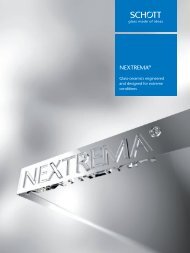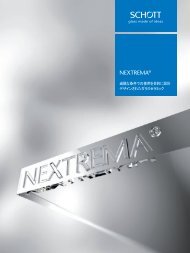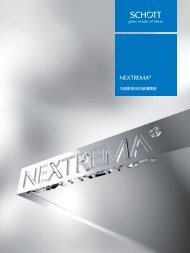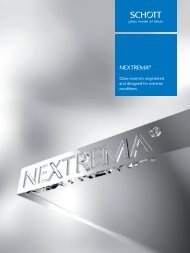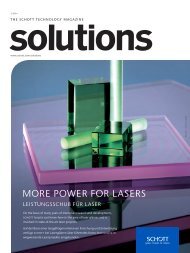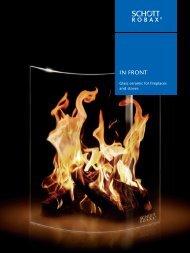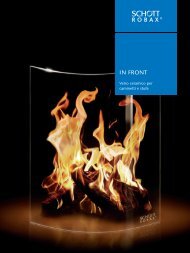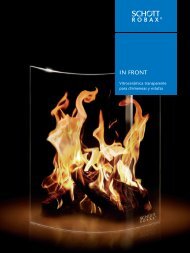SCHOTT Technical Glasses
Apart from its application in optics, glass as a technical material has exerted a formative influence on the development of important technological fields such as chemistry, pharmaceutics, automotive, optics, optoelectronics and information technology. SCHOTT Technical Glasses offers pertinent information in concise form. It contains general information for the determination and evaluation of important glass properties and also informs about specific chemical and physical characteristics and possible applications of the commercial technical glasses produced by SCHOTT. With this brochure, we hope to assist scientists, engineers, and designers in making the appropriate choice and make optimum use of SCHOTT products.
Apart from its application in optics, glass as a technical material has exerted a formative influence on the development of important technological fields such as chemistry, pharmaceutics, automotive, optics, optoelectronics and information technology. SCHOTT Technical Glasses offers pertinent information in concise form. It contains general information for the determination and evaluation of important glass properties and also informs about specific chemical and physical characteristics and possible applications of the commercial technical glasses produced by SCHOTT. With this brochure, we hope to assist scientists, engineers, and designers in making the appropriate choice and make optimum use of SCHOTT products.
You also want an ePaper? Increase the reach of your titles
YUMPU automatically turns print PDFs into web optimized ePapers that Google loves.
25<br />
The transmittance τ d at perpendicular incidence decreases<br />
correspondingly to values between 93.1 % and 90.6 %.<br />
The reflection r d of a parallel glass plate can be reduced<br />
(and its total transmittance τ d can be increased) by using<br />
so-called anti-reflective (AR) coatings. In its simplest form,<br />
a transparent layer on each surface with n layer = √ — n glass and<br />
a thickness of λ/4/n layer will reduce the reflection for perpendicular<br />
incidence and wavelength λ completely. For other<br />
wavelengths close to λ, the reflection is reduced but not<br />
canceled. With more complex multy-layer AR coatings,<br />
reflections in the visible range can be reduced to less than<br />
1 % per surface.<br />
The internal transmittance τ i of an absorbing glass is a function<br />
of the thickness d:<br />
τ i = e –αd , where α is the spectral absorption coefficient.<br />
The relation between spectral transmittance τ and spectral<br />
internal transmittance τ i is:<br />
τ(λ) =<br />
( 2n(λ)<br />
n(λ) 2 + 1) τ i(λ)<br />
The dependence of the factor<br />
( 2n(λ)<br />
n(λ) 2 + 1)<br />
on wavelength is usually small, thus, a constant<br />
reflection factor P<br />
5.3 Transmittance<br />
Normally, glass is transparent to visible light and certain regions<br />
of UV and IR radiation. Losses in transmittance occur<br />
due to internal absorption and reflection, as indicated above.<br />
The so-called internal transmittance τ i can be modified<br />
by using coloring agents (oxides of transition elements or<br />
colloids) or fine particles in the glass, which have different<br />
refractive indices (light scattering).<br />
P d =<br />
2n d<br />
n d<br />
2<br />
+ 1<br />
is sufficient for use in most cases.<br />
The best UV transmission is achieved with pure fused<br />
silica (UV cut-off for 1 mm thickness is in the region<br />
of 160 – 180 nm); particularly good UV-transmitting multicomponent<br />
glasses have cut-offs of up to 220 nm wavelength<br />
(Figure 21); normal technical glasses (Figure 22)<br />
already absorb considerably at 300 nm.<br />
5<br />
100<br />
8337B<br />
100<br />
90<br />
80<br />
8405<br />
80<br />
70<br />
60<br />
60<br />
50<br />
1 mm<br />
8 mm<br />
40<br />
40<br />
Transmission in % ––><br />
20<br />
0<br />
200 250 300 350 400<br />
Wavelength in nm ––><br />
Fig. 21. UV transmission of highly UV-transparent technical glass types<br />
8337B and 8405 at 0.5 mm glass thickness<br />
Transmission in % ––><br />
30<br />
2 mm<br />
20<br />
10<br />
0<br />
200 500 1000 2000 5000 10000<br />
Wavelength in nm ––><br />
Fig. 22. Transmission of DURAN ® 8330 for thicknesses 1, 2 and 8 mm






